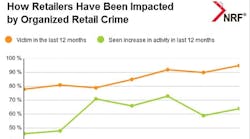Organized retail crime isn’t only costly for businesses, it’s dangerous, and the problem extends far beyond stores, according to NRF’s seventh annual Organized Retail Crime survey. Of the 129 retail companies surveyed this year, nearly all (94.5%) have been the victim of organized retail crime in the past 12 months, an increase over last year and the most in the survey’s history.
An increasing number of retailers said thieves are becoming more brazen and that, on average more than one in 10 organized retail crime apprehensions (13%) lead to some level of violence, such as physical assault and/or battery.
“Organized retail crime affects virtually every single retailer in America, impacting everything from the bottom line to the safety of people in the stores,” said NRF senior asset protection advisor Joe LaRocca. “As criminals become more brazen, retailers are working fervently to cut down on organized retail crime activity in order to ensure the safety of their associates and shoppers.”
Not only are criminals becoming more violent, members of these crime rings are often engaged in other illegal activities. According to the survey, retailers estimate that 41 percent of apprehended offenders are involved in “gateway” crimes including drugs, weapons and gang activity. Additionally, retailers report that, on average, 12 percent of their organized retail crime cases involve collusion between internal and external actors, shedding light on the substantial role a handful of corrupt employees can play in organized retail crime.
In addition to the increase in the number of retailers who have been victimized, the level of organized retail crime activity has continued to increase. According to the survey, 84.8 percent of retailers believe organized retail crime activity has increased within the last three years.
As the economy forces retail executives to pay close attention to every line item in their budgets, loss prevention executives say senior leadership is more likely to understand how organized retail crime impacts the company’s bottom line. Over half of survey respondents (58.3%) believe their top management understands organized retail crime, a 16 percent increase over last year. As a result, many companies are allocating additional resources – including more personnel and greater investment in technology – to combat the problem.
Cargo Theft a Major Problem
While organized retail crime has historically highlighted coordinated thefts in stores, retailers were asked for the first time this year what threats exist before the merchandise even reaches the shelves. Results indicate that organized retail crime should not be an issue solely addressed at the store level, as half of retailers (49.6%) say they have been a victim of cargo theft in the past 12 months. While theft often occurs en route from the distribution center to the store (57.4%), retailers are also victimized at other points along the supply chain, including between the manufacturer and the distribution center (39.7%), at the distribution center (22.1%), and as merchandise moves from one store to another (22.1%).“Cargo theft is a rewarding, profitable enterprise, and criminals are increasingly finding ways to infiltrate the supply chain,” said LaRocca. “As thieves target shipping containers, retailers and law enforcement are fighting back with new initiatives and operations to directly address cargo theft.”
Las Vegas, Phoenix Added to Top 10 Crime Cities
The survey also asked retailers what cities were the most problematic for organized retail crime rings. The top cities, in alphabetical order, are:
• Atlanta, GA
• Chicago, IL
• Dallas, TX
• Houston, TX
• Las Vegas, NV
• Los Angeles, CA
• Miami, FL
• New York, NY/Northern NJ
• Philadelphia, PA
• Phoenix, AZ
Fight Back Through Partnerships
Retailers know that organized retail crime is not a problem they can tackle alone. The Federal Bureau of Investigation, Immigration Customs and Enforcement-Homeland Security Investigations Agency and the Department of Homeland Security have collaborated in monitoring and apprehending criminal enterprises known for their organized retail crime activities.
In February 2011, ICE-HSI announced the expansion of its Organized Retail Crime Pilot Program into an ongoing, national initiative, which will be known as the SEARCH initiative (Seizing Earnings and Assets from Retail Crime Heists). This initiative began with a pilot program that involved numerous retailers throughout the country, which used retailers’ own intelligence to track suspected crime rings.
In 2009, NRF and other industry associations - with the full support from the FBI and retailers from around the country - announced a partnership with eBay, the world’s largest online marketplace, to tackle organized retail crime together. eBay’s Partnering with Retailers Offensively Against Crime and Theft PROACT program aims to identify and stop criminals who resell stolen goods online.
NRF Launches Organized Retail Crime Information Center
In conjunction with the release of the 2011 Organized Retail Crime survey, NRF has launched a resource center offering the latest information on organized retail crime. Visit www.nrf.com/organizedretailcrime for news articles, blog posts, statistics and legislative updates.
About the Survey
The 2011 NRF Organized Retail Crime survey was conducted from April 19 – May 10, 2011 by the National Retail Federation. Senior loss prevention executives at 129 retail companies completed the survey with the purpose of identifying the depth of organized retail crime throughout the entire industry. This year’s survey features responses from executives representing department/large box stores, discount, drug, grocery, restaurant and specialty retailers.
As the world's largest retail trade association and the voice of retail worldwide, the National Retail Federation's global membership includes retailers of all sizes, formats and channels of distribution as well as chain restaurants and industry partners from the U.S. and more than 45 countries abroad. In the U.S., NRF represents the breadth and diversity of an industry with more than 1.6 million American companies that employ nearly 25 million workers and generated 2010 sales of $2.4 trillion.




